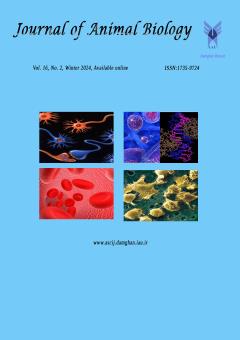اثر آویشن شیرازی بر آسیب کبدی القا شده ناشی از تتراکلرید کربن بر موشهای نر بالغ نژاد ویستار
الموضوعات : فصلنامه زیست شناسی جانوریزهرا طاهرخانی 1 , اکرم عیدی 2 , پژمان مرتضوی 3
1 - گروه زيست شناسي، واحد علوم و تحقيقات، دانشگاه آزاد اسلامي، تهران، ايران
2 - گروه زيست شناسي، واحد علوم و تحقيقات، دانشگاه آزاد اسلامي، تهران، ايران
3 - گروه دامپزشکی، واحد علوم و تحقيقات، دانشگاه آزاد اسلامي، تهران، ايران
الکلمات المفتاحية: آویشن, Zataria multiflora Boiss, کبد, تتراکلریدکربن, موش صحرایی,
ملخص المقالة :
آویشن (Zataria multiflora Boiss) از خانواده Labiatae، بومی ایران است و به طور سنتی در غذاها به ویژه در طعم دهنده ماست، به عنوان محرک، چاشنی و بادشکن استفاده میشود. خواص دارویی بسیار بالای این گیاه از جمله فعالیت آنتی اکسیدانی، ضد میکروبی، ضد درد و ضد التهابی گزارش شده است. این تحقیق با هدف بررسی اثرات محافظتی عصاره اتانولی آویشن در برابر آسیب کبدی ناشی از تتراکلریدکربن (CCl4) در موشهای صحرایی نر بالغ نژاد ویستار انجام شد. 40 موش صحرایی در 8 گروه بصورت تصادفی قرار گرفتند: گروه 1 به عنوان کنترل سالم، گروههای 4-2 فقط عصاره آویشن (50، 100، 200 میلیگرم بر کیلوگرم، گاواژ)، گروه 5 (آسیب کبدی) دریافت کننده CCl4(5/0 میلیلیتر بر کیلوگرم، درون صفاقی، دو بار در هفته) به مدت 8 هفته و گروههای 6 تا 8 عصاره آویشن (50، 100، 200 میلیگرم بر کیلوگرم، گاواژ) به همراه CCl4(5/0 میلیلیتر بر کیلوگرم، درون صفاقی، دو بار در هفته) دریافت کردند. در پایان آزمایش (28 روز)، نمونههای سرمی تهیه و کبد برای بررسیهای آنزیمی خارج شد. CCl4 به تنهایی سطح سرمی ALT، AST و ALP را افزایش داد. همچنین، تیمار CCl4 به صورت معنی داری باعث کاهش سطح آنزیم آنتی¬اکسیدانی سوپراکسید دیسموتاز ( SOD) و افزایش مالون دی آلدئید (MDA) در کبد شد. تیمار عصاره آویشن به صورت معنی داری باعث بهبود پارامترهای فوق گردید. بنابراین، نتایج نشان میدهد که آویشن به عنوان یک عامل آنتی اکسیدانی قوی در برابر آسیب کبدی ناشی از CCl4 در موشها عمل میکند.
1. Ahmadipour A., Sharififar F., Nakhaipour F., Samanian M., Karami-Mohajeri S. 2015. Hepatoprotective effect of Zataria Multiflora Boiss on cisplatin-induced oxidative stress in male rat. Journal of Medicine and Life, 8:275-281.
2. Apostolova N., Blas-Garcia A., Esplugues J.V. 2011. Mitochondria sentencing about cellular life and death: a matter of oxidative stress. Current Pharmaceutical Design, 17(36):4047-4060.
3. Arab Z., Hosseini M., Marefati N., Beheshti F., Anaeigoudari A., Sadeghnia H.R. 2022. Neuroprotective and memory enhancing effects of Zataria multiflora in lipopolysaccharide-treated rats. Veterinary Research Forum, 13(1):101-110.
4. Attia Y.A.., Bakhashwain A.A., Bertu N.K. 2017. Thyme oil (Thyme vulgaris L.) as a natural growth promoter for broiler chickens reared under hot climate. Italian Journal of Animal Science, 16:275-282.
5. Attia Y.A., Bakhashwain A.A., Bertu N.K. 2018. Utilisation of thyme powder (Thyme vulgaris L.) as a growth promoter alternative to antibiotics for broiler chickens raised in a hot climate. European Poultry Science, 82:238-243.
6. Ayala A., Muñoz M.F., Argüelles S. 2014. Lipid peroxidation: production, metabolism, and signaling mechanisms of malon dialdehyde and 4-hydroxy-2-nonenal. Oxidative Medicine and Cellular Longevity, 2014(6):360438.
7. Castagliuolo I., Brun P., Busiello I., Miraglia N., Gnosis SpA. 2017. Formulations containing Saccharomyces boulardii and superoxide dismutase (SOD) to control obesity. U.S. Patent 9,555,082.
8. Fatemi F., Asri Y., Rasooli I., Alipoor S.D., Shaterloo M. 2012. Chemical composition and antioxidant properties of γ-irradiated Iranian Zataria multiflora extracts. Pharmaceutical Biology, 50(2):232-238.
9. Gholami-Ahangaran M, Ahmadi-Dastgerdi A, Azizi S, Basiratpour A, Zokaei M., Derakhshan M. 2022. Thymol and carvacrol supplementation in poultry health and performance. Veterinary Medicine and Science, 8(1):267-288.
10. Khajavi R.A., Mohebbati R. 2018. Zataria multiflora extract and carvacrol affect cardiotoxicity induced by Adriamycin in rat. Journal of Basic Clinical Physiology and Pharmacology, 30(1):73-79.
11. Lee S., Won K.Y., Joo S. 2020. Protective effect of poly deoxy ribonucleotide against CCl4-induced acute liver injury in mice. International Neurology Journal, 24(Suppl 2):88-95.
12. Masuda Y Yakugaku Z. 2006. Learning toxicology from carbon tetrachloride-induced hepatotoxicity. Yakugaku Zasshi. 126(10):885-899. [In Japanese].
13. Mohebbati R., Paseban M., Beheshti F., Soukhtanloo M., Shafei M.N., Rakhshandeh H. 2018. The Preventive effects of standardized extract of Zataria multiflora and carvacrol on acetaminophen-induced hepatotoxicity in rat. Journal of Pharmacopuncture, 21(4):249-257.
14. Muriel P., Rivera-Espinoza Y. 2008. Beneficial drugs for liver diseases. Journal of Applied Toxicology, 28(2):93-103.
15. Nobakht M., Darmani-kuhi H., Mohiti-Asli M. 2017. Effect of Zataria multiflora boiss (thyme) extract and fat on meat quality, intestinal pH and serum antioxidant status of broiler chicks. Animal Production Research Anim Prod Res, 6:51-61.
16. Pan Y., Long X., Yi R., Zhao X. 2018. Polyphenols in liubao tea can prevent CCl₄-induced hepatic damage in mice through its antioxidant capacities. Nutrients, 10(9):1280-1291.
17. Sahreen S., Khan M.R., Khan R.A. 2011. Hepatoprotective effects of methanol extract of Carissa opaca leaves on CCl4-induced damage in rat. BMC Complementary Alternative Medicine, 11:48-57.
18. Shomali T., Mosleh N. 2019. Zataria multiflora, broiler health and performance: a review. Iranian Journal of Veterinary Research, 20(2):81-88.
19. Singh N., Kamath V., Narasimhamurthy K., Rajini P.S. 2008. Protective effect of potato peel extract against carbon tetrachloride-induced liver injury in rats. Environmental Toxicology and Pharmacology, 26(2):241-246.
20. Sreelatha S., Padma P.R. 2009. Antioxidant activity and total phenolic content of Moringa oleifera leaves in two stages of maturity. Plant Foods and Human Nutrition, 64:303-311.
21. Srivastava A., Shivanandappa T. 2010. Hepatoprotective effect of the root extract of Decalepis hamiltonii against carbon tetrachloride-induced oxidative stress in rats. Food Chemistry, 118:411-417.
22. Trefts E., Gannon M., Wasserman D.H. 2017. The liver. Current Biology, 27(21):R1147-R1151.
23. Unsal V., Cicek M., Sabancilar İ. 2020. Toxicity of carbon tetrachloride, free radicals and role of antioxidants. Reviews on Environmental Health, 36(2):279-295.
24. Wang K., Sui D.J., Wang C.S., Yang L., Ouyang Z., Chen N.F. 2017. Protective effects of five different types of Dendrobium on CCl4-induced liver injury in mice. Zhongguo Zhong Yao Za Zhi. 42(10):1945-1950. [In Chinese].
25. Zhang C., Zhao J., Famous E., Pan S., Peng X., Tian J. 2021. Antioxidant, hepatoprotective and antifungal activities of black pepper (Piper nigrum L.) essential oil. Food Chemistry, 346:128845.


